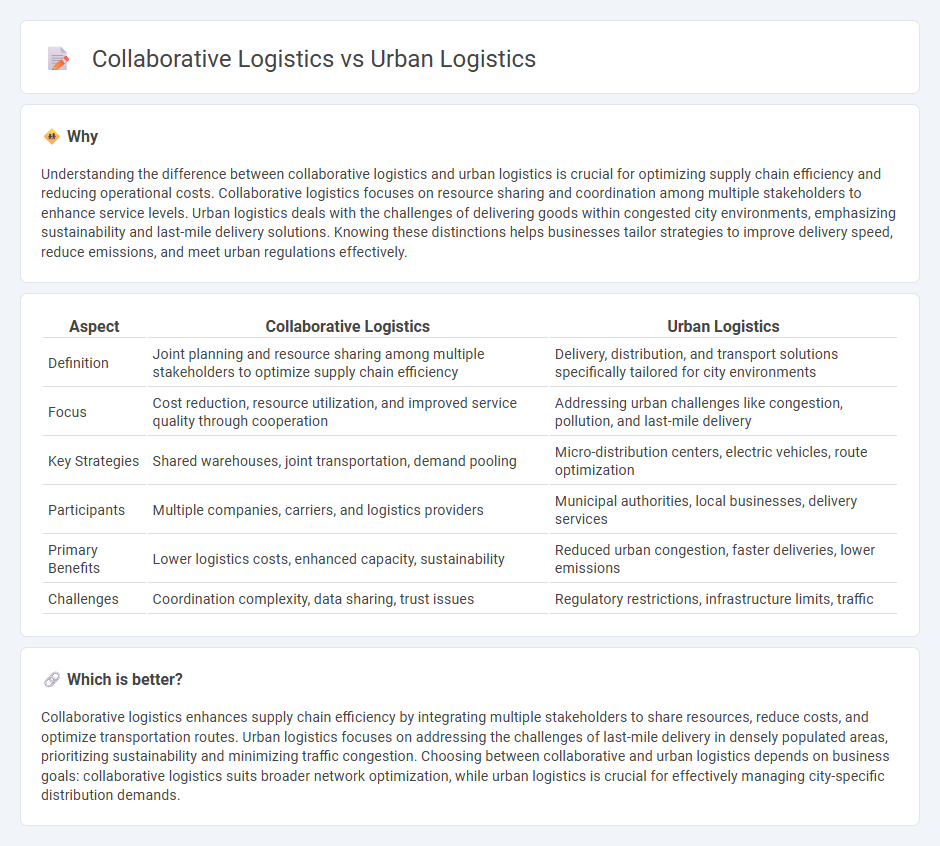
Collaborative logistics maximizes efficiency by integrating resources and information across multiple stakeholders, reducing costs and environmental impact through shared transportation and warehousing. Urban logistics focuses on optimizing the movement of goods within congested city environments, addressing challenges like traffic, emissions, and last-mile delivery bottlenecks. Discover how combining collaborative and urban logistics strategies transforms supply chain resilience and sustainability.
Why it is important
Understanding the difference between collaborative logistics and urban logistics is crucial for optimizing supply chain efficiency and reducing operational costs. Collaborative logistics focuses on resource sharing and coordination among multiple stakeholders to enhance service levels. Urban logistics deals with the challenges of delivering goods within congested city environments, emphasizing sustainability and last-mile delivery solutions. Knowing these distinctions helps businesses tailor strategies to improve delivery speed, reduce emissions, and meet urban regulations effectively.
Comparison Table
| Aspect | Collaborative Logistics | Urban Logistics |
|---|---|---|
| Definition | Joint planning and resource sharing among multiple stakeholders to optimize supply chain efficiency | Delivery, distribution, and transport solutions specifically tailored for city environments |
| Focus | Cost reduction, resource utilization, and improved service quality through cooperation | Addressing urban challenges like congestion, pollution, and last-mile delivery |
| Key Strategies | Shared warehouses, joint transportation, demand pooling | Micro-distribution centers, electric vehicles, route optimization |
| Participants | Multiple companies, carriers, and logistics providers | Municipal authorities, local businesses, delivery services |
| Primary Benefits | Lower logistics costs, enhanced capacity, sustainability | Reduced urban congestion, faster deliveries, lower emissions |
| Challenges | Coordination complexity, data sharing, trust issues | Regulatory restrictions, infrastructure limits, traffic |
Which is better?
Collaborative logistics enhances supply chain efficiency by integrating multiple stakeholders to share resources, reduce costs, and optimize transportation routes. Urban logistics focuses on addressing the challenges of last-mile delivery in densely populated areas, prioritizing sustainability and minimizing traffic congestion. Choosing between collaborative and urban logistics depends on business goals: collaborative logistics suits broader network optimization, while urban logistics is crucial for effectively managing city-specific distribution demands.
Connection
Collaborative logistics enhances urban logistics by integrating shared resources and data among multiple stakeholders to optimize last-mile delivery and reduce traffic congestion. Urban logistics benefits from collaborative platforms that enable real-time coordination, route optimization, and efficient use of urban infrastructure. This synergy improves supply chain efficiency, cuts emissions, and addresses urban challenges such as limited delivery windows and high population density.
Key Terms
**Urban Logistics:**
Urban logistics optimizes the delivery and distribution of goods within densely populated city areas, addressing challenges such as traffic congestion, limited loading zones, and environmental regulations. It integrates technologies like route optimization, electric vehicles, and micro-distribution centers to enhance efficiency and reduce carbon emissions. Discover how urban logistics transforms city supply chains and supports sustainable urban living.
Last-mile delivery
Urban logistics prioritizes efficient last-mile delivery solutions to navigate dense city environments, emphasizing speed, reduced congestion, and eco-friendly transportation modes. Collaborative logistics leverages shared resources among multiple stakeholders, enhancing route optimization and cost savings while minimizing carbon footprints during last-mile delivery. Discover how integrating these approaches can revolutionize urban last-mile logistics.
Urban consolidation center
Urban logistics prioritizes efficient last-mile delivery in densely populated areas, often facing challenges such as congestion and pollution. Collaborative logistics, particularly through Urban Consolidation Centers (UCCs), consolidates shipments from multiple suppliers to optimize routes, reduce delivery frequency, and lower environmental impact. Explore how UCCs transform urban freight management for smarter, sustainable city logistics.
Source and External Links
What is Urban Logistics? Definition, Challenges, and Strategies - This article provides an overview of urban logistics, focusing on its role in optimizing the distribution of goods and services within urban areas.
Urban Logistics: Clear regulations crucial - Discusses how complexities in regulations impact urban logistics, particularly in terms of delivery time windows and transportation restrictions.
Five things you should know about urban logistics - Highlights key aspects of urban logistics, including its rapid growth, diverse demand for space, and specific facility needs for efficient operations.
 dowidth.com
dowidth.com